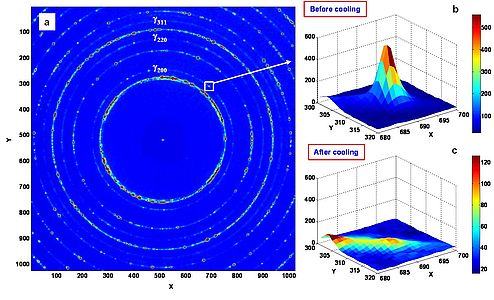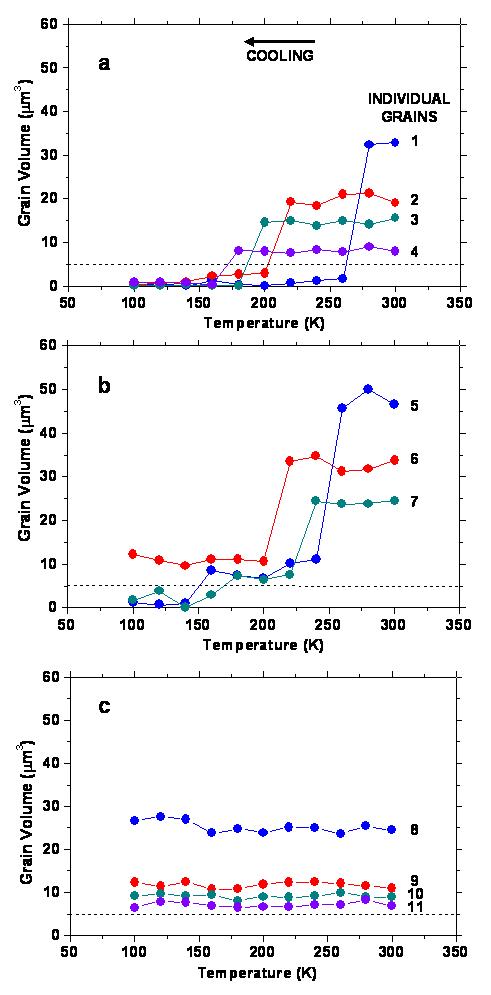Stability of retained austenite in TRIP steels during cooling
Recently, low-alloyed transformation induced plasticity (TRIP) steels have attracted a growing interest for their high strength and good formability. TRIP steels possess a multiphase microstructure containing ferrite (alpha-Fe), bainite, and (metastable) austenite (gamma-Fe). The so-called TRIP effect in these steels arises from a martensitic transformation of the metastable retained austenite phase induced by external stress. It was found experimentally and theoretically that the austenite volume fraction, the carbon concentration in the austenite grains, and the grain size of the retained austenite play a crucial role in the TRIP properties as they significantly affect the mechanical stability of the retained austenite.
We have studied the volume fraction of retained austenite as a function of the chemical composition and the bainitic holding time by X‑ray diffraction, and SQUID magnetisation [7]. The average austenite grain size was characterised by neutron depolarisation measurements [6]. By in-situ X-ray diffraction measurements at a synchrotron source [8] we characterised the phase stability of the retained austenite under applied stress. These measuments allowed us to correlate the stability of the austenite grain to the relative orientation with respect to the applied stress.
An alternative way to study the phase stability of the retained austenite in TRIP steels with a better accuracy is to cool the material to low temperatures, and thereby increase the temperature-dependent chemical driving force for the martensitic transformation of the metastable retained austenite. In previous magnetisation measurements [9] we have demonstrated that part of the retained austenite in TRIP steels can indeed become unstable during cooling.
In addition we have performed unique in-situ X-ray diffraction measurements at a synchrotron source [1-5] in order to study the thermal stability of the retained austenite phase in TRIP steels during cooling from room temperature to 100 K. A powder analysis [5] of the diffraction data reveals a martensitic transformation of part of the retained austenite during cooling. The fraction of austenite that transforms during cooling is found to depend strongly on the bainitic holding time and the composition of the steel. It is shown that that austenite grains with a lower average carbon concentration have a lower stability during cooling.
A recent single grain analysis of the individual austenite reflections [1-4] reveals the transformation behaviour of individual grains as shown in Figure 1. Three different types of transformation behaviour can be observed during cooling (Figure 2). The transformation temperature of the metastable austenite grains was found to depend not only on the interstitial carbon content, but also on their grain site.


References:
- [1] E. Jimenez-Melero, N.H. van Dijk, L. Zhao, J. Sietsma, S.E. Offerman, J.P. Wright, S. van der Zwaag, The effect of aluminium and phosphorus on the stability of individual austenite grains in TRIP steels, Acta Materialia 57 (2009) 533-543. [PDF]
- [2] E. Jimenez-Melero, N.H. van Dijk, L. Zhao, J. Sietsma, S.E. Offerman, J.P. Wright, and S. van der Zwaag, Characterisation of individual retained austenite grains and their stability in low-alloyed TRIP steels, Acta Materialia 55 (2007) 6713-6723. [PDF]
- [3] E. Jimenez-Melero, N.H. van Dijk, L. Zhao, J. Sietsma, S.E. Offerman, J.P. Wright, and S. van der Zwaag, Martensitic transformation of individual grains in low-alloyed TRIP steels,
Scripta Materialia 56 (2007) 421-424. [PDF] - [4] E. Jimenez-Melero, N.H. van Dijk, L. Zhao, J. Sietsma, and S. van der Zwaag, A novel 2D analysis method to study individual grains using high-energy X‑ray microbeam diffraction, Advances in X-ray Analysis 51 (2007) 69-75. [PDF]
- [5] N.H. van Dijk, A.M. Butt, L. Zhao, J. Sietsma, S.E. Offerman, J.P. Wright, and S. van der Zwaag, Thermal stability of retained austenite in TRIP steels studied by synchrotron X-ray diffraction during cooling, Acta Materialia 53 (2005) 5439-5447. [PDF]
- [6] N.H. van Dijk, L. Zhao, M.Th. Rekveldt, H. Fredrikze, O. Tegus, E. Brück, J. Sietsma, and S. van der Zwaag, Neutron depolarisation study on the austenite grain size in TRIP steels, Physica B 350 (2004) e463-e466. [PDF]
- [7] L. Zhao, N.H. van Dijk, E. Brück, J. Sietsma, and S. van der Zwaag, Magnetic and X‑ray determination of retained austenite in TRIP steels, Materials Science and Engineering A 313 (2001) 145-152. [PDF]
- [8] S.O. Kruijver, L. Zhao, J. Sietsma, S.E. Offerman, N.H. van Dijk, L. Margulies, E.M. Lauridsen, S. Grigull, H.F. Poulsen, and S. van der Zwaag, In situ observations on the austenite stability in TRIP steel during tensile testing, Steel Research 73 (2002) 236-241. [PDF]
- [9] L. Zhao, O. Tegus, E. Brück, N.H. van Dijk, S. Kruijver, J. Sietsma, S. van der Zwaag, Magnetic determination of thermal stability of retained austenite in TRIP steel, Proceedings International Conference on TRIP-Aided High Strength Ferrous Alloys, Gent, Belgium, 19-21 June 2002, Editor: De Cooman DC. Aachen: Wissenschaftsverlag Mainz GmbH; 2002. p. 71. [PDF]